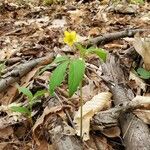Plants perennial, caulescent, not stoloniferous, 10–40 cm. Stems 1(2), erect, leafless proximally, leafy distally, glabrous or puberulent, from subligneous rhizome. Leaves basal and cauline; basal: 0(–2); stipules ovate, not leaflike, margins entire, apex acute to acuminate, surfaces glabrous or puberulent; petiole 9–11.5 cm, glabrous or puberulent; blade unlobed, ovate, or 3–5-lobed, 4–5 × 1–5 cm, base cordate, margins entire or crenate-serrate, ciliate or eciliate, apex acute, surfaces glabrous or ± puberulent; cauline similar to basal except: restricted to distal ends of stems; stipules ovate to oblong; petiole 0.7–7.2 cm, glabrous or puberulent; blade unlobed, ovate or deltate, or 3-lobed (if 3-lobed, lateral lobes falcate, middle rhombic, longer than others, lobes may appear petiolate; unlobed and 3-lobed leaves can occur on same plant), 1–6 × 0.5–5.5 cm, base truncate to cuneate, margins serrate, ciliate or eciliate, surfaces glabrous or pubescent. Peduncles 1.5–4 cm, glabrous or pubescent. Flowers: sepals lanceolate to ovate, margins ciliate or eciliate, auricles 0.1–0.5 mm; petals lemon-yellow adaxially, upper 2, rarely others, brownish purple abaxially, lowest and usually lateral 2 brownish purple-veined, lateral 2 and sometimes lowest bearded, lowest 10–18 mm, spur yellow, gibbous, 0.5–2 mm; style head bearded; cleistogamous flowers axillary. Capsules ovoid to ellipsoid, 9–12 mm, glabrous. Seeds beige, bronze, or brown, 2.4–3 mm. 2n = 12.
More
Plants 1.5–4.5 dm from a short rhizome, usually puberulent or glandular-puberulent above; lvs 2–4(–7) near the top of the stem, 3–10 cm, often some (sometimes all) of them ovate to lance-ovate with long tip and truncate to broadly tapering base, usually some or all ± deeply 3-cleft, the terminal segment the largest; fls on slender, erect, axillary peduncles; sep lance-linear, ciliolate; pet bright yellow with brown-purple lines toward the base, the lateral ones bearded; style with a capitate, bearded summit; frs stoutly ellipsoid, 8–10 mm; seeds pale. Rich woods; sw. Pa. and s. O. to N.C., S.C., Ga., Ala., and ne. Miss. Apr., May.


